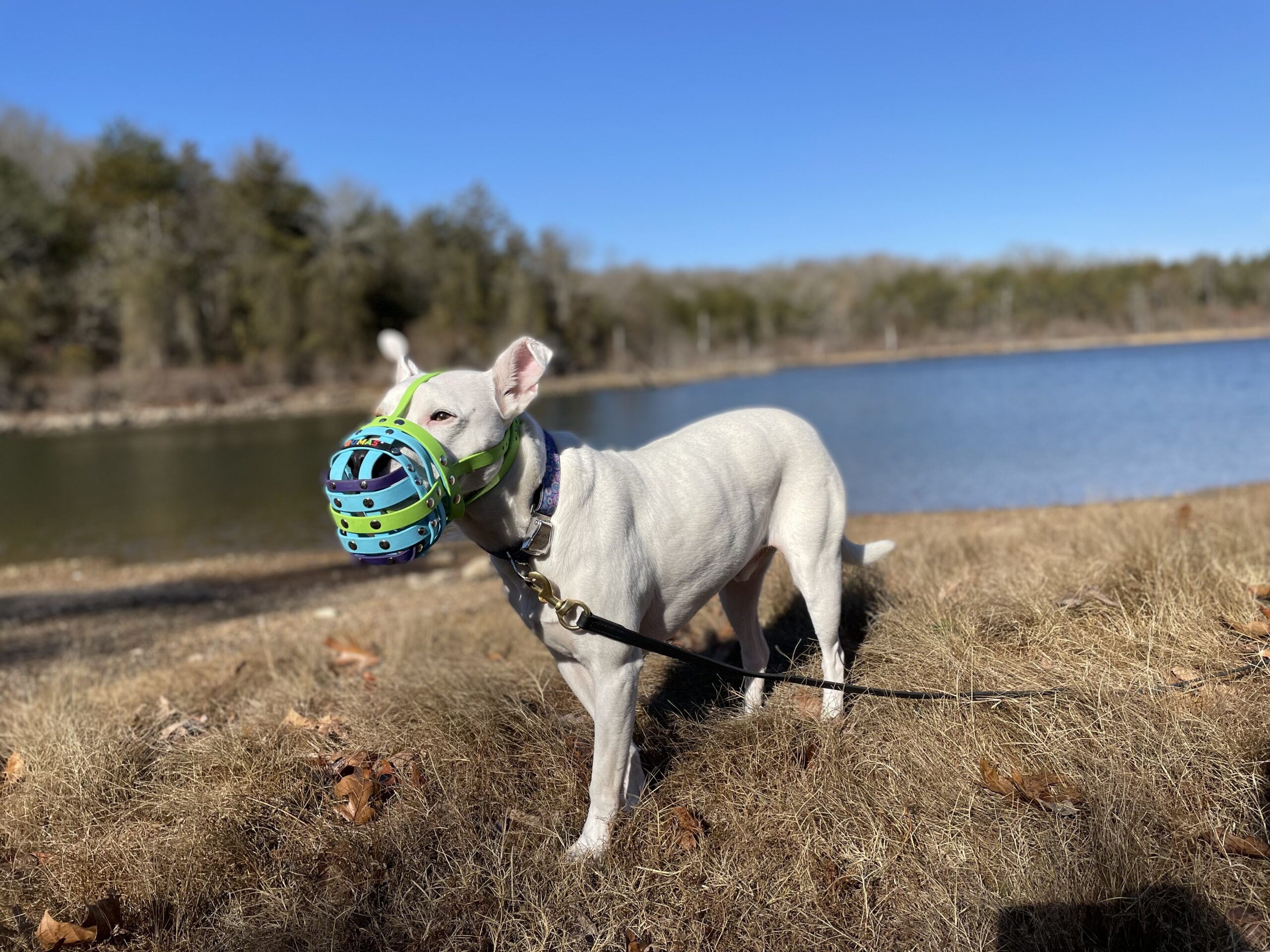Disclaimer: If you purchase items through links on our site we may earn a commission.
Does your dog nip, growl, snarl, snap or bite? Lunge and bark at other animals or people? Do you think your dog might injure someone or another dog? Does he eat rocks or other inedible things? If you answer yes to any of these questions, your dog needs a muzzle. Don’t wait for a bite or foreign body surgery before getting your dog muzzle trained.
What is a dog muzzle?
Dog muzzles are similar to masks but with holes, designed to prevent a dog from engaging in dangerous behaviors like biting. They’re a tool to keep everyone safe and help with training. Dog muzzles are mainly for short-term use (i.e., while undergoing a training or behavior modification) or for specific purposes like vet visits or on walks.
Why do dogs need a dog muzzle?
Dogs can benefit from muzzle training since sometimes vet visits, nail trims or even new environments or introductions to new species (like your new backyard chickens) can be challenging and your dog can be provoked to bite or lunge. But let’s face it: we don’t see many dogs wearing what seems like some sort of medieval torture device. And if we do, we might stereotype muzzle-wearing dogs as aggressive, and wonder what the heck the owner was doing to the dog that he needs a cage on his face. But dogs who wear muzzles aren’t “bad dogs,” they just need space.
Dogs who wear muzzles could be struggling with any number of issues like:
- fear
- anxiety
- stress
- medical issues
Melissa Hatfield, certified behavior consultant and trial consultant for bite cases, says muzzles provide an extra level of safety during the training process. But for some dogs, wearing a muzzle may be a lifelong commitment in certain situations like going for a walk, when the small children come over or even visits to the vet or groomer. As much as training can reduce the potential for risk, there are some dogs who will never be reliable enough to go without this safety net, says Melissa.
Do not use dog muzzles for barking or chewing
Muzzles are not for barking, chewing or other troublesome behaviors. Oftentimes these behaviors are the result of lack of stimulation and exercise or other needs not being met. Certified dog trainer Cindy Martin says a muzzle is not a substitute for addressing the physical and emotional needs of the dog. And without behavior modification and affirmative training, a muzzle can stress the dog and make things worse, says Cindy.
How to find the right muzzle for your dog
Before training your dog to a muzzle, be sure you get the proper type and fit. Muzzles should fit securely yet comfortably. A properly fitted muzzle should feel to the dog like wearing a pair of glasses feels to us — like it’s not even there.
Basket muzzles are popular since they allow for dogs to pant, receive treats and drink. They’re also light-weight, flexible and inexpensive. A popular choice is the thermoplastic rubber Baskerville dog muzzle, which is also adjustable by submerging it in hot water.
My dog Apache’s muzzle is custom made of biothane by BUMAS.
Pricey, but since he wears it every time he leaves the house, and it’s made especially for him, it was worth it. It accommodates his full pant, drinking and treats. I was also able to select the colors and added security features. A similar less expensive option is made by Trust Your Dog.
If you have an extra-large dog or one with a slim, long snout, the vinyl Jafco dog muzzle is a great option.
And for brachycephalic dogs, check out the Canine Friendly Short Snout dog muzzle. Dogs can’t drink with this muzzle but can eat and pant.
For dogs who are a bite risk, wire basket muzzles, such as the Leerburg dog muzzle, can be a safe choice.
Avoid cloth and Velcro muzzles that force a dog’s mouth shut and restrict necessary functions.
How to get your dog to wear a muzzle
Take the time to train your dog to enjoy wearing his muzzle. If your training is blah your dog will be blah about the muzzle; you need your dog to feel like he’s at a rave or a rock concert when he sees the muzzle, not a black-tie affair.
If trained properly, your dog will voluntarily place his snout into the muzzle. Don’t force it onto your dog’s face! Muzzle training done right should take a few weeks. Cindy’s favorite tip is to first acclimate the dog to the sensation of putting his muzzle into a closed space using a cottage cheese or one quart yogurt container with the bottom cut out. Feed awesome treats from the cutout end, building duration.
Muzzle training isn’t as easy as teaching sit or rollover but should be just as fun and well reinforced. Take your time with each step.
Here is our step-by-step guide to dog muzzle training:
- Start by showing your dog the muzzle. Any positive attention gets a million-dollar treat or two (or five). Don’t skimp here — treat well.
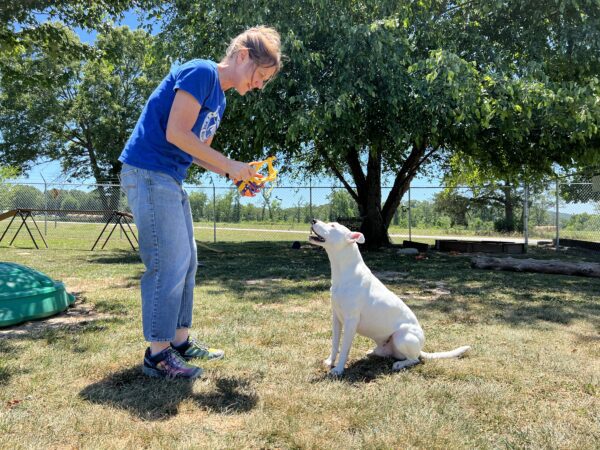
First, ensure your dog is happy to see the muzzle by giving him treats whenever you show it to him. ©Rachel Brix - Put food inside the muzzle and set it up in a box/bowl and let him eat. Any hesitation, stop and go back to the previous step. Up your pay game if you have to: chicken, liver, tripe, cheese, steak, whatever. You want the muzzle to have wow factor! Do this for at least a week ideally at least a couple times per day. If your dog’s totally cool (not just kind of cool, but super-pumped cool) when he sees the muzzle, you’re ready for the next step; if not, stay here. Keep at it until you see a happy dance from your dog when you bust out the muzzle.
- Next, invite your dog to place his snout inside the muzzle and feed from the outside. DON’T force it — if he’s not putting his snout in voluntarily, back up a step.
- Then hold the straps in place for a second or two and release. Treat some more. If your dog is giving the green light, increase the duration slowly each day.
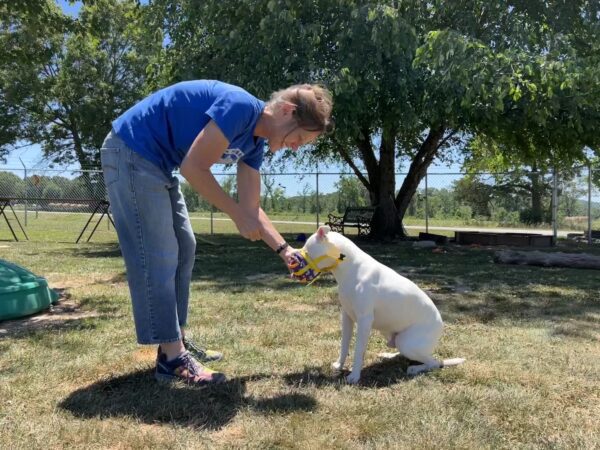
Have your dog place his snout inside the muzzle and hold it in place for a few seconds and then release. ©Rachel Brix - At the end of the second week, you should be able to attach the straps for a second or two, then release.
- By the end of the third week, you’ve worked up to longer periods of wear: some yard time, a short walk, or while you return a few emails. Whatever, just so he gets used to having it on for longer periods.
- Generalize to other situations and environments.
Dog muzzle training tips:
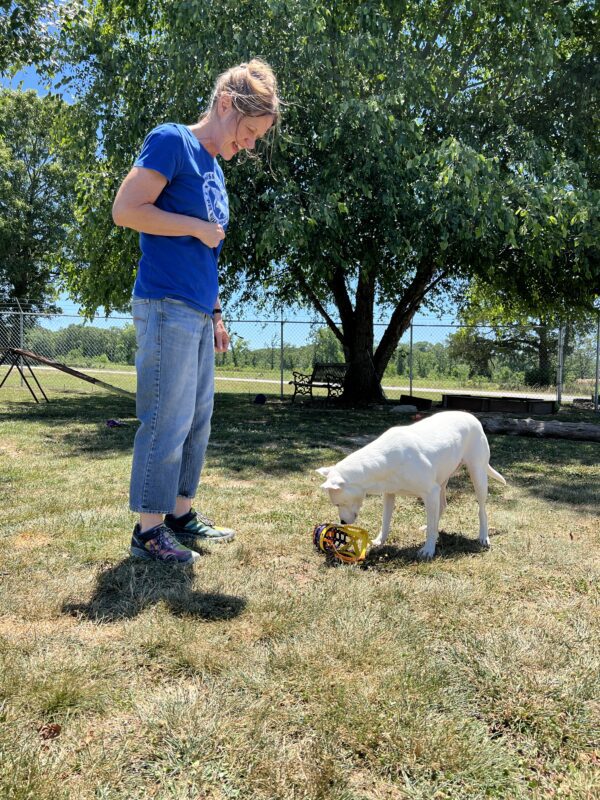
- DON’T rush this. Your dog dictates the pace.
- If your dog’s not happy-dancing, back it up a step, break out the million-dollar treats and work to get the rockstar reaction you need to get the all-in from your dog.
- Muzzled dogs should always be supervised.
- Take the muzzle off before signs of frustration or annoyance (i.e., reluctance to putting his face in voluntarily, pawing, etc.).
- If he paws at the muzzle once it’s on, back up to the previous step of success and work there. But don’t remove the muzzle while he’s pawing at it- you don’t want to reward the pawing behavior.
Here are two good muzzle training videos by Chirag Patel and Michael Shikashio
While muzzles are a great management tool, they’re not a substitute for training. If your dog is displaying troublesome behaviors first address the underlying emotions causing these behaviors. Rewards-based trainers, behavior consultants and even veterinary behaviorists can help.
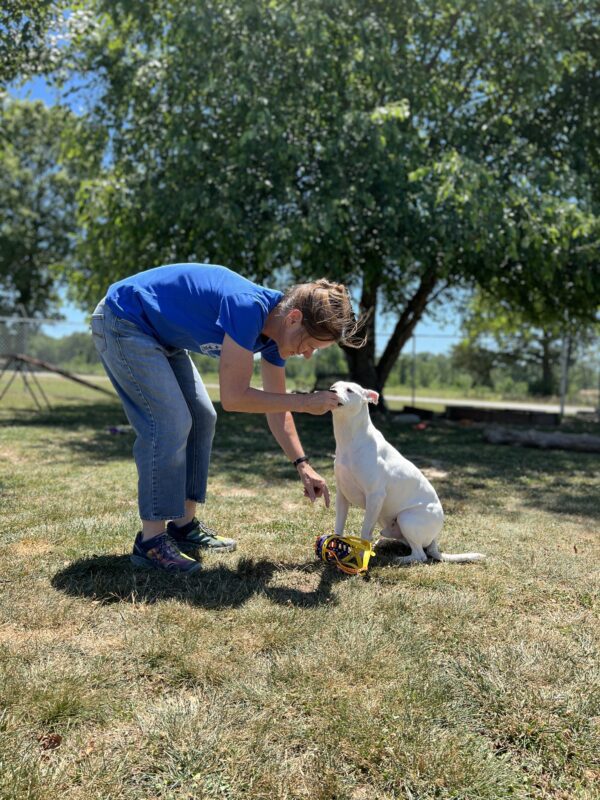
Muzzles keep everyone safe and help dogs (and humans in many cases) enjoy a greater quality of life. Melissa says having the option of wearing a muzzle can give dogs freedom to experience a variety of situations they normally wouldn’t be able to while adding an extra layer of safety for all concerned.
Truth be told, long before I became a trainer, I was one of those open-mouthed gawkers when I saw a muzzled dog. But several years ago, I adopted Apache, a long termer at a rural shelter who will always wear his muzzle in public. And that’s okay. Muzzles keep everyone safe. And at the end of the day, that’s the most important thing.

